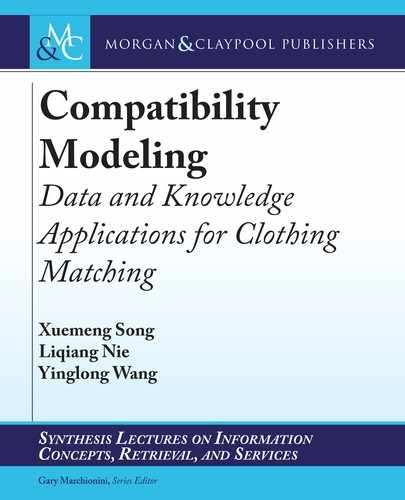3.3. METHODOLOGY 15
3.3.1 NOTATION
Formally, we first declare some notations. In particular, we use bold uppercase letters (e.g., X)
and bold lowercase letters (e.g., x) to denote matrices and vectors, respectively. We employ non-
bold letters (e.g., x) to represent scalars and Greek letters (e.g., ˇ) to stand for parameters. If
not clarified, all vectors are in column forms. Let
A
F
and
x
2
denote the Frobenius norm
of matrix A and the Euclidean norm of vector x, respectively.
3.3.2 PROBLEM FORMULATION
In a sense, people prefer to choose clothes with high compatibility, such as a silk pushy bow
blouse plus a mini skirt or wool pullover plus a tweed flap skirt to make a harmonious outfit.
Consequently, in this work, we focus on the compatibility modeling toward clothing matching.
Suppose we have a set of tops T D ft
1
; t
2
; : : : ; t
N
t
g and bottoms B D fb
1
; b
2
; : : : ; b
N
b
g, where N
t
and N
b
denote the total number of tops and bottoms, respectively. For each t
i
(b
i
), we use v
t
i
(v
b
i
)
2 R
D
v
and c
t
i
(c
b
i
) 2 R
D
c
to represent its visual and contextual input features, respectively. D
v
and D
c
denote the dimensions of the corresponding input features. In addition, we have a set
of positive top-bottom pairs S D f.t
i
1
; b
j
1
/; .t
i
2
; b
j
2
/; : : : ; .t
i
N
; b
j
N
/g extracted from the outfit
compositions on Polyvore, where N denotes the number of positive pairs. Accordingly, each
top t
i
has a positive bottom set B
C
i
D fb
j
2 Bj.t
i
; b
j
/ 2 Sg. Let m
ij
denote the compatibility
between top t
i
and bottom b
j
. In this work, we aim to propose an accurate model to measure
m
ij
, based on which we can generate a ranking list of b
j
’s for a given t
i
.
3.3.3 NONLINEAR COMPATIBILITY SPACE
Obviously, it is not advisable to directly measure the compatibility between fashion items from
distinct spaces due to their heterogeneity. erefore, we assume that there is a latent compat-
ibility space that is able to bridge the gap between heterogenous fashion items, where highly
compatible fashion items that share similar style, material, or functionality should also show
high similarity. In fact, the factors contributing to compatibility may diversely range from style
and color, to material and shape. Moreover, the relationship among these factors can be highly
sophisticated. For example, a white casual T-shirt goes well with black casual jeans but not a
black suit, while a pair of high boots prefers skinny leggings rather than flared pants. Toward
this end, in this work, we further assume that the subtle compatibility factors lie in a highly
nonlinear space, which can be learned by the advanced neural network models. In particular, we
employ the autoencoder networks to learn the latent space, which has been proven to be effective
in the latent space learning [118].
Autoencoder, which works in an unsupervised manner, consists of two parts: the encoder
and decoder. e former maps the input data to the latent representation space, while the latter
works toward mapping the latent representation space to a reconstruction space, both of which
work based on multiple nonlinear functions. Suppose the encoder consists of K layers of nonlin-
ear transformation. Given the input x, the hidden representation for each layer can be calculated
..................Content has been hidden....................
You can't read the all page of ebook, please click here login for view all page.
